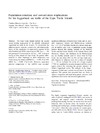Identificador persistente para citar o vincular este elemento:
https://accedacris.ulpgc.es/jspui/handle/10553/17592
| Título: | Population structure and conservation implications for the loggerhead sea turtle of the Cape Verde Islands | Autores/as: | Monzón-Argüello, Catalina Rico, Ciro Naro Maciel, Eugenia Varo-Cruz, Nuria López, Pedro Marco, Adolfo López-Jurado, Luis Felipe |
Clasificación UNESCO: | 24 Ciencias de la vida 2401 Biología animal (zoología) 240116 Herpetología |
Palabras clave: | Conservation genetics Mitochondrial DNA Microsatellites Caretta Macaronesia Population structure |
Fecha de publicación: | 2010 | Publicación seriada: | Conservation Genetics | Resumen: | The Cape Verde Islands harbour the second largest nesting aggregation of the globally endangered loggerhead sea turtle in the Atlantic. To characterize the unknown genetic structure, connectivity, and demographic history of this population, we sequenced a segment of the mitochondrial (mt) DNA control region (380 bp, n = 186) and genotyped 12 microsatellite loci (n = 128) in females nesting at three islands of Cape Verde. No genetic differentiation in either haplotype or allele frequencies was found among the islands (mtDNA FST = 0. 001, P > 0. 02; nDNA FST = 0. 001, P > 0. 126). However, population pairwise comparisons of the mtDNA data revealed significant differences between Cape Verde and all previously sequenced Atlantic and Mediterranean rookeries (FST = 0. 745; P < 0. 000). Results of a mixed stock analysis of mtDNA data from 10 published oceanic feeding grounds showed that feeding grounds of the Madeira, Azores, and the Canary Islands, in the Atlantic Ocean, and Gimnesies, Pitiüses, and Andalusia, in the Mediterranean sea, are feeding grounds used by turtles born in Cape Verde, but that about 43% (±19%) of Cape Verde juveniles disperse to unknown areas. In a subset of samples (n = 145) we evaluated the utility of a longer segment (~760 bp) amplified by recently designed mtDNA control region primers for assessing the genetic structure of Atlantic loggerhead turtles. The analysis of the longer fragment revealed more variants overall than in the shorter segments. The genetic data presented here are likely to improve assignment and population genetic analyses, with significant conservation and research applications. | URI: | https://accedacris.ulpgc.es/handle/10553/17592 | ISSN: | 1566-0621 | DOI: | 10.1007/s10592-010-0079-7 | Fuente: | Conservation Genetics [ISSN 1566-0621], v. 11, p. 1871-1884 |
| Colección: | Artículos |
Citas SCOPUSTM
85
actualizado el 08-jun-2025
Citas de WEB OF SCIENCETM
Citations
83
actualizado el 12-ene-2026
Visitas
60
actualizado el 10-ene-2026
Descargas
250
actualizado el 10-ene-2026
Google ScholarTM
Verifica
Altmetric
Comparte
Exporta metadatos
Los elementos en ULPGC accedaCRIS están protegidos por derechos de autor con todos los derechos reservados, a menos que se indique lo contrario.
